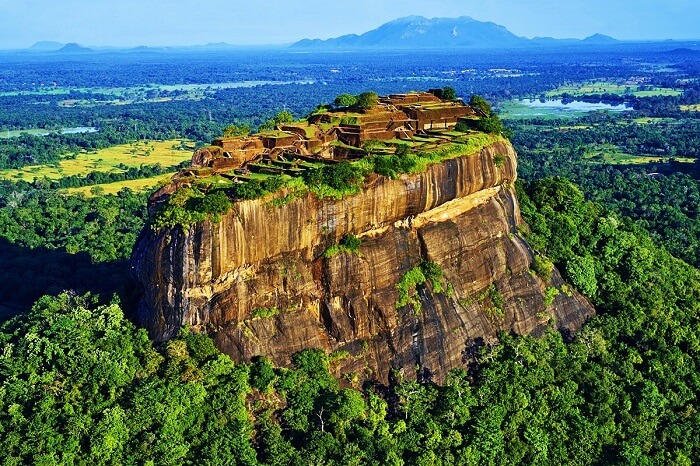Some call it Sigiriya. Others call it Sinhagiri. In any case, it is an ancient rock fortress located in the northern Matala District near the town of Dambulla, in Sri Lanka. The site is of historical and archaeological significance. Dominated by a massive column of rock approximately 180m, the area was once a large forest.
According to the ancient Sri Lankan chronicle the Culavamsa, this area was a large forest. But after some storms and landslides, the area became a hill. Selected by King Kashyapa for his new capital. He ruled between 477 and 495 AD. Kashyapa built his palace on top of the rock and decorated its sides with colorful frescoes.
![]()
The royal palace was used as a Buddhist monastery until the 14th century. Today, the place is listed as a UNESCO World Heritage Site. Critics praise it as an example of ancient urban planning.
History of the Place
Before we go to some of the unique facts about this place, let’s talk about its history. We touched on it briefly, but now let’s talk more.
The area may have been inhabited since prehistoric times. Evidence show that rock shelters and caves in the area were occupied by Buddhist monks and ascetics from as early as the third century BC. The earliest evidence of human habitation indicates the area was populated during the Mesolithic Period, nearly five thousand years ago.
![]()
During the 3rd century BC, Buddhist monastic settlements were established in the western and northern slopes surrounding the Sigiriya rock. These shelters, made under large boulders, with carved drip ledges around the cave mouths, were made between 3rd century BCE and the 1st century AD.
The place got famous during the reign of King Kashyapa I, the king’s son by a non-royal consort. He seized the throne from King Dhatusena. The rightful heir, Moggallana, fearing for his life, fled to South India.
Kashyapa was afraid of an attack, so he moved the capital and his residence from the traditional capital to the more secure Sigiriya. During his reign, the area was developed into a complex and fortress. Most of the constructions date from this period.
But eventually, he would kill himself, refusing to fail to Moggallana. The rightful heir returned the capital to its traditional place, Anuradhupura, converting Sigiriya to a Buddhist monastery complex. It survived until the 13th or 14th century.
Then, there were no records of the area until the 17th century, when it was used as an outpost of the Kingdom of Kandy.
Unique facts about the place
Now that we know the history of the Sigiriya complex, let’s talk about some unique facts about the place. What makes it special? Read along.
– The rock is 200m high and it takes 1,200 steps to reach the top. That is the only way to access the wonders of Sigiriya. Now you see why it was almost impossible to invade it?
![]()
– We talked how King Kasyapa had no right to the throne. He was born to his father’s non-royal mistres. But he rebelled against his father. Because of fear, he built this place to be almost impossible to conquer
– The entrance is through a gateway in the form of a huge lion. King Kashyapa built a gateway on a plateau located halfway up the rock. The staircase emerges from a lion’s mouth and is guarded by a pair of monumental lion’s paws. This is why some people call the place Lion Rock
– The site became a UNESCO World Heritage Site in 1982, considered one of the best-preserved examples of ancient urban planning
– The King created a mirror wall, which is now inscribed by visitor graffiti. The highly polished walls was designed so that the King could see his reflection from walking by. It is now known as Sigiri Graffiti, there are messages dating to the 8th century CE. It shows the development of the Sinhala language and script
– There is a citadel, upper palace on top of the igneous rock, and lower palaces among the many impressive archaeological features and architectural features of the place
![]()
– British Army Major Jonathan Forbes rediscovered the area in 1831. He came across it during a horseback ride
– The area has an advanced hydraulic system, consisting of canals, lakes, dams, bridges, and water pumps. They provide water to the gardens to this day
– The area was featured in the eleventh episode of The Amazing Race 6 in 2005



